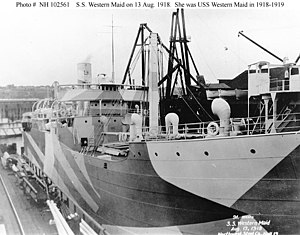SS Western Maid
 Western Maid, 13 August 1918
| |
| History | |
|---|---|
| Name |
|
| Owner |
|
| Operator |
|
| Port of registry | |
| Builder | Northwest Steel Co |
| Yard number | 13 |
| Launched | 8 July 1918 |
| Completed | August 1918 |
| Commissioned | 17 August 1918 |
| Decommissioned | 20 March 1919 |
| Maiden voyage | 21 August 1918 |
| In service | 21 August 1918 |
| Out of service | 1 October 1945 |
| Identification | |
| Fate | Scuttled |
| General characteristics | |
| Type | Cargo ship[1] |
| Tonnage | |
| Length | 409.8 feet (124.9 m) between perpendiculars;[1] 423 ft 9 in (129.16 m) overall[citation needed] |
| Beam | 54.2 ft (16.5 m)[1] |
| Draught | 24 feet 0½ inch (7.33 m)[citation needed] |
| Depth | 27.2 ft (8.3 m)[1] or 29 ft 9 in (9.07 m)[citation needed] |
| Installed power | 594 NHP[1] |
| Propulsion | DeLaval double reduction-geared steam turbine;[1] single screw |
| Speed | 15 knots (28 km/h)[3] |
| Complement | 70[citation needed] |
Western Maid was a 5,760 GRT
Description
The ship was built in 1918 by
She had a depth of 27.2 ft (8.3 m)[1] or 29 ft 9 in (9.07 m)[citation needed] and a draught of 24 feet 1⁄2 inch (7.33 m).[7] Her tonnages were 5,760 GRT,[1] 5,139 tons under deck;[1] 3,503 NRT[1] 12,185 DWT.[6]
Her engine was a
History
Originally laid down as Aisne for the
Western Maid started her maiden voyage on 21 August 1918, transporting a cargo of flour from Portland to
Western Maid was decommissioned on 20 March 1919 and returned to the USSB.
Empire Cormorant was a member of Convoy HS 36, which departed
Scuttling
In 1945 Empire Cormorant was loaded with a cargo of obsolete chemical ammunition and on 1 October she was scuttled in the North Atlantic beyond the continental shelf, 120 nautical miles (138 miles; 222 km) northwest of Ireland.[4][15] Her wreck is at 55°30′N 11°00′W / 55.500°N 11.000°W in 8,200 feet (2,500 m) of water.[15]
Empire Cormorant was one of four redundant cargo ships that the
References
- ^ a b c d e f g h i j k l m n o p q Lloyd's Register of Shipping (PDF). London: Lloyd's Register. 1930. Retrieved 31 March 2013.
- ^ a b c Lloyd's Register of Shipping (PDF). London: Lloyd's Register. 1941. Retrieved 31 March 2013.
- ^ a b "SS Empire Cormorant [+1945]". Wrecksite. Retrieved 16 April 2011.
- ^ ISBN 1-85044-275-4.
- ^ "General Cargo Ships Built in Pacific Coast Shipyards". Shipbuilding History. Retrieved 16 March 2011.
- ^ a b c d "S.S. Western Maid (American Freighter, 1918). Served as USS Western Maid (ID # 3703) in 1918-1919". Naval History & Heritage Command. Retrieved 16 April 2011.
- ^ a b c "Western Maid". Dictionary of American Naval Fighting Ships. Navy Department, Naval History and Heritage Command. Retrieved 16 April 2011.
- ^ "THE WESTERN MAID, 257 U. S. 419 (1922)". US Supreme Court Center. Retrieved 16 April 2011.
- ^ a b "EMPIRE - C". Mariners. Retrieved 16 April 2011.
- ^ "Convoy HS.36". Convoyweb. Retrieved 16 April 2011.
- ^ "CONVOY SC 97". Warsailors. Retrieved 16 April 2011.
- ^ "Convoy SL.140 / MKS.31". Convoyweb. Retrieved 16 April 2011.
- ^ "Spitfire Production page 013". Spitfire. Retrieved 16 April 2011.
- ^ "Spitfire Production page 026". Spitfire. Retrieved 16 April 2011.
- ^ a b Bowles, R. British Isles Explosive Dumping Grounds. London: Ministry of Defence. p. 2.
- ^ Lettens, Jan; Allen, Tony (27 December 2010). "Pentridge Hill SS (1936~1939) Lambridge SS [+1945]". The Wreck Site. Retrieved 20 June 2011.

